| 1 |
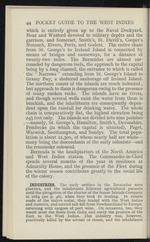 |
“...white-
many being the descendants of the early colonists1—and
the remainder coloured.
Bermuda is the headquarters of the North America
and West Indies station. The Commander-in-Chief
spends several months of the year in residence at
Admiralty House, and the presence of the Fleet during
the winter season contributes greatly to the social life
of the colony.
INDUSTRIES. The early settlers in the Bermudas were
planters, and the inhabitants followed agricultural pursuits
until the abrogation of the charter of the Somer Islands Company
in 1684 {see p. 46), when they took to trading. In vessels
made of the native cedar, they traded with the West Indies
and America, and carried salt fish from Newfoundland to Europe,
returning with cargoes of port wine. On occasions, too, they
would meet the fleets from India and carry the produce of the
East to the West Indies. This industry was, however,
practically killed by the advent of steam, and the inhabitants...”
|
|
| 2 |
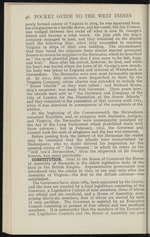 |
“...there almost starved prompted j
Somers to return for supplies to the Bermudas, which he described j
as " the most plentiful place that I ever came to for fish, hogs, j
and fowl.” Soon after his arrival, however, he died, and while
his heart was buried where the town of St. George’s now stands, j
his body was taken to England and interred at Whitchurch in
Dorsetshire. The Bermudas were now most favourably spoken i
of. In 1612, fifty settlers were despatched to them by the
Virginia Company, whose charter was extended to include the j
" Somer Islands ” as they were called ; and Richard Moore, ■
ship’s carpenter, was made first Governor. Three years later, j
the islands were sold to " the Governor and Company of the 1
City of London for the. Plantation of the Somer Islands,”
and they remained in the possession of that concern until 1684, j
when it was dissolved in consequence of the complaints of the
settlers.
At the beginning of the Commonwealth the Bermudians
remained Royalists, and, in company...”
|
|
| 3 |
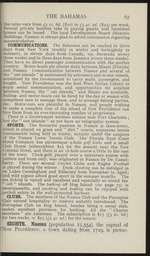 |
“...good sport in the summer months. The
1 sea fishing is varied and excellent and especially so round the
I* out ” islands. The bathing off Hog Island (see page 73) is
unsurpassable, and yachting and boating can be enjoyed with
perfect safety in the well-protected harbour.
CLUBS. The members of the Nassau Club and the Porcupine
[Club extend hospitality to visitors suitably introduced. The
[Porcupine Club on Hog Island, besides being a social club,
[makes excellent provision for bathing. All the “ Charter
[members ” are American. The subscription is $15 (£3 2s. 6d.)
(for two weeks, or $25 (£5.45. 2d.) for the season.
SIGHTS. Nassau (population 12,554), the capital of
[New Providence, a town dating from 1729, is pictur-...”
|
|
| 4 |
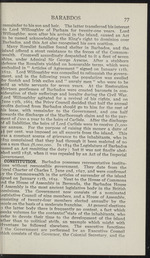 |
“...duty of
I? Per cent- was imposed on all exports from the island. This
vas a constant source of grievance to the inhabitants, who in
r832 complained that they had through it been mulcted of no
ess a sum than £6,000,000. In 1834 the Legislature of Barbados
lassed an Act remitting the duty ; but it was not finally abol-
'overnment838' Whe" was rePealed by an Act of the Imperial
CONSTITUTION. Barbados possesses representative institu-
rions without responsible government, They date from the
.oyal Charter of Charles I, June 2nd, 1627, and were confirmed
>y the Commonwealth in the articles of surrender of the island
ccJanuary nth, 1652. Next to the House of Commons
ind the House of Assembly in Bermuda, the Barbados House
f Assembly is the most ancient legislative body in the British
(ominions. The Government now consists of a nominated
legislative Council of nine members, and a House of Assembly
onsistmg of twenty-four members elected annually by thé
eople on the basis of a moderate franchise....”
|
|
| 5 |
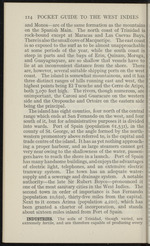 |
“...Spain
has many handsome buildings, and enjoys the advantages
of electric light, telephones, and an extensive electric
tramway system. The town has an adequate water-
supply and a sewerage and drainage system. A notable
authority—the late Sir Rubert Boyce—pronounced it
one of the most sanitary cities in the West Indies, The
second town in order of importance is San Fernando
(population 10,610), thirty-five miles from the capital.
Next to it comes Arima (population 4,210), which has
been granted a charter of incorporation, and stands
about sixteen miles inland from Port of Spain.
INDUSTRIES. The soils of Trinidad, though varied, are
extremely fertile, and are therefore capable of producing every...”
|
|
| 6 |
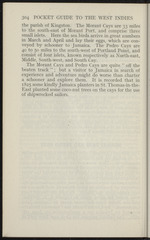 |
“... of Morant Port, and comprise three
small islets. Here the sea birds arrive in great numbers
in March and April and lay their eggs, which are con-
veyed by schooner to Jamaica. The Pedro Cays are
40 to 50 miles to the south-west of Portland Point, and
consist of four islets, known respectively as North-east,
Middle, South-west, and South Cay.
The Morant Cays and Pedro Cays are quite " off the
beaten track ” ; but a visitor to Jamaica in search of
experience and adventure might do worse than charter
a schooner and explore them. It is recorded that in
1825 some kindly Jamaica planters in St. Thomas-in-the-
East planted some coco-nut trees on the cays for the use
of shipwrecked sailors....”
|
|
| 7 |
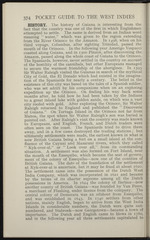 |
“...Kyk-over-al,” or " Look over all,” from its commanding
situation. A settlement was also formed on Fort Island, near
the mouth of the Essequibo, which became the seat of govern-
ment of the colony of Essequibo—now one of the counties of
British Guiana. The date of the foundation of the settlement
at Kyk-over-al is uncertain, but it may be fixed at about 1620.
The settlement came into the possession of the Dutch West
India Company, which was incorporated in 1621 and became
by the terms of its charter supreme among all the Dutch
possessions in America. In 1624 the colony of Berbice—now
another county of British Guiana—was founded by Van Peere,
a merchant of Flushing, under licence from the company. The
central colony of Demerara was an offshoot from Essequibo,
and was established in 1645. In 1740 settlers from other
nations, mainly English, began to arrive from the West India
Islands in considerable numbers, the Dutch were quite out-
numbered, and Stabroek—now Georgetown—became a town of
...”
|
|
| 8 |
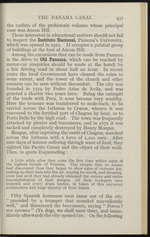 |
“...1911. It occupies a palatial group
of buildings at the foot of Ancon HUT.
Among the excursions that can be made from Panama
is the drive to Old Panama, which can be reached by
motor-car (enquiries should be made at the hotel) by
a fair driving road in about half an hour. In recent
years the local Government have cleared the ruins to
some extent, and the tower of the church and other
remains can be seen without discomfort. The city was
founded in 1519 by Pedro Arias de Avila, and was
granted a charter two years later. Being the entrepót
of the trade with Peru, it soon became very wealthy.
Here the treasure was transferred to mule-back, to be
carried across the Isthmus to Cruces, whence it was
conveyed to the fortified port of Chagres by boat, or to
Porto Bello by the high road. The town was frequently
attacked by pirates and buccaneers, and in 1671 it was
sacked and completely destroyed by Henry Morgan.
Morgan, after capturing the castle of Chagres, marched
across the Isthmus with a force...”
|
|
| 9 |
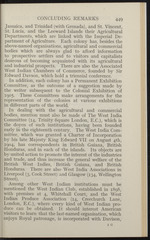 |
“...a suggestion made by
the writer subsequent to the Colonial Exhibition of
1905. These Committees make arrangements for the
representation of the colonies at various exhibitions
in different parts of the world.
In dealing with the agricultural and commercial
bodies, mention must also be made of The West India
Committee (14, Trinity Square London, E.C.), which is
the doyen of such institutions, having been founded
early in the eighteenth century. The West India Com-
mittee, which was granted a Charter of Incorporation
by his late Majesty King Edward VII on August 4th,
1904, has correspondents in British Guiana, British
Honduras, and in each of the islands. Its objects are
by united action to promote the interest of the industries
and trade, and thus increase the general welfare of the
British West Indies, British Guiana, and British
Honduras. There are also West India Associations in
Liverpool (3, Cook Street) and Glasgow (134, Wellington
Street).
Among other West Indian institutions must...”
|
|
| 10 |
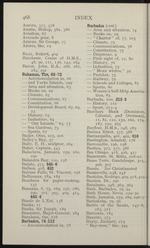 |
“...Bay, 57
Baily, E. H., sculptor, 264
Baker, Captain, 443
Balaclava, Jamaica, 259, 260,
290
Balandra Bay, 120, 138
Balata, 373, 445-6
Balboa, 428, 432
Baleine Falls, St. Vincent, 198
Balliceaux, 184, 185
Bamboos for paper-making,
137
Bananas, 8, 75, 169, 256, 286,
290, 311, 393, 409, 414,
443-4
Bande de L’Est, 138
Banks, n
Banks, Sir Joseph, 189
Bannister, Major-General, 284
Barabara, the, 178
Barbados, 74-112
— Accommodation in, 78
Barbados (cont.)
—• Area and situation, 74
— Books on, 29
— " Charter” of, 77, 105
— Climate, 75
— Communications, 78
— Constitution, 77
—— Dripstone, 9
— First sight of, 22, 80
— History, 76
— Industries, 75
— " Mean whites,” 39
— Parishes, 75
— Railway, 79
— Schools and Colleges, 87
— Sports, 80
— Women’s Self-Help Associa-
tion, 85
Barbuda, 200, 212-5
— History, 212
—- Sport, 213-4
Barclays Bank (Dominion,
Colonial, and Overseas),
n, 82, 122, 150, 160, 174,1
187, 220, 265
Barfleur, H.M.S., 248, 283
Barima River, 377, 388
Barranquilla, 401, 402, 410
Barrington...”
|
|
| 11 |
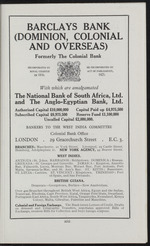 |
“...BARCLAYS BANK
(DOMINION, COLONIAL
AND OVERSEAS)
Formerly The Colonial Bank
RE-INCORPORATED BY
ACT OF PARLIAMENT,
1925.
With which are amalgamated
The National Bank of South Africa, Ltd.
and The Anglo-Egyptian Bank, Ltd.
Authorised Capital £10,000,000 Capital Paid up £4,975,500
Subscribed Capital £6,975,500 Reserve Fund £1,100,000
Uncalled Capital £2,000,000.
INCORPORATED BY
ROYAL CHARTER
IN 1836.
BANKERS TO THE WEST INDIA COMMITTEE
Colonial Bank Office
LONDON . 29 Gracechurch Street . E.C. 3.
BRANCHES: Manchester, 21 York Street. Liverpool, 25 Castle Street.
Hamburg, Adolphsplatz iv. NEW YORK AGENCY, 44 Beaver Street.
WEST INDIES.
ANTIGUA: St. Johns. BARBADOS : Bridgetown. DOMINICA: Roseau.
GRENADA : St. Georges and Grenville. JAMAICA : Kingston, Annotto
Bay, Falmouth, Lucea, Montego Bay, Morant Bay, Port Antonio, Port
Maria, Savanna-la-Mar, and St. Ann’s Bay. ST. KITTS: Basseterre.
ST. LUCIA: Castries. ST. VINCENT: Kingstown. TRINIDAD : Port
of Spain, and San Fernando.
BRITISH GUIANA....”
|
|
| 12 |
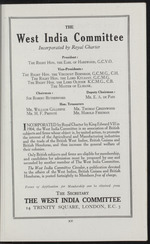 |
“...THE
West India Committee
Incorporated by Royal Charter
President:
The Right Hon. the Earl of Harewood, G.C.V.O.
Vice-Presidents:
The Right Hon. the Viscount Burnham, G.C.M.G., C.H.
The Right Hon. the Lord Kylsant, G.C.M.G.
The Right Hon. the Lord Olivier K.C.M.G., C.B.
The Master of Elibank.
Chairman : Deputy Chairman :
Sir Robert Rutherford Mr. E. A. dePass
Hon. Treasurers
Mr. William Gillespie Mr. Thomas Greenwood
Mr. H. F. Previté Mr. Harold Freeman
T NCORPORATED by Royal Charter by King Edward VII in
A1904, the West India Committee is an association of British
subjects and firms whose object is, by united action, to promote
the interest of the Agricultural and Manufacturing industries
and the trade of the British West Indies, British Guiana and
British Honduras, and thus increase the general welfare of
their colonies.
Only British subjects and firms are eligible for membership,
and candidates for admission must be proposed by one and
seconded by another member of The West India Committee...”
|
|
